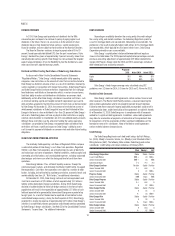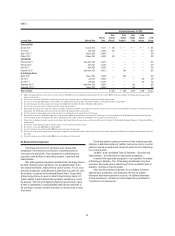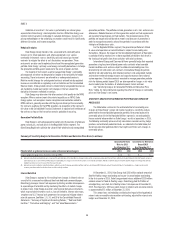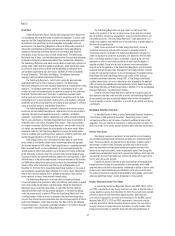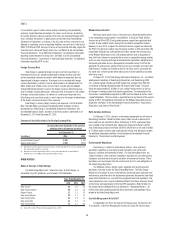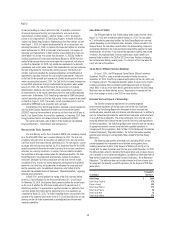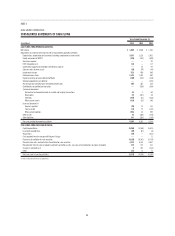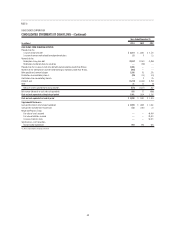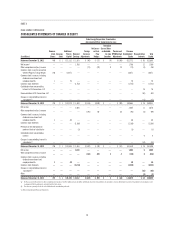Duke Energy 2014 Annual Report Download - page 81
Download and view the complete annual report
Please find page 81 of the 2014 Duke Energy annual report below. You can navigate through the pages in the report by either clicking on the pages listed below, or by using the keyword search tool below to find specific information within the annual report.
61
PART II
The Duke Energy Registrants routinely take steps to reduce the potential
impact of severe weather events on their electric distribution systems.
The Duke Energy Registrants’ electric generating facilities are designed to
withstand extreme weather events without signifi cant damage. The Duke Energy
Registrants maintain an inventory of coal and oil on site to mitigate the effects
of any potential short-term disruption in fuel supply so they can continue to
provide customers with an uninterrupted supply of electricity. The Duke Energy
Registrants have a program in place to effectively manage the impact of future
droughts on their operations.
Nuclear Matters
Following the events at the Fukushima Daiichi nuclear power station
in Japan, Duke Energy conducted thorough inspections at each of its seven
nuclear sites during 2011. The initial inspections did not identify any signifi cant
vulnerabilities, however, Duke Energy is reviewing designs to evaluate safety
margins to external events. Emergency-response capabilities, written procedures
and engineering specifi cations were reviewed to verify each site’s ability to
respond in the unlikely event of station blackout. Duke Energy is working within
the nuclear industry to improve safety standards and margin using the three
layers of safety approach used in the U.S.: protection, mitigation and emergency
response. Emergency equipment is currently being added at each station to
perform key safety functions in the event that backup power sources are lost
permanently. These improvements are in addition to the numerous layers of
safety measures and systems previously in place.
In March 2011, the NRC formed a task force to conduct a comprehensive
review of processes and regulations to determine whether the agency should
make additional improvements to the nuclear regulatory system. On July 13,
2011, the task force proposed a set of improvements designed to ensure
protection, enhance accident mitigation, strengthen emergency preparedness
and improve effi ciency of NRC programs. The recommendations were further
prioritized into three tiers based on the safety enhancement level. On March 12,
2012, the NRC issued three regulatory orders requiring safety enhancements
related to mitigation strategies to respond to extreme natural events resulting in
the loss of power at a plant, ensuring reliable hardened containment vents and
enhancing spent fuel pool instrumentation.
On August 30, 2012, the NRC issued implementation guidance to enable
power plants to achieve compliance with the orders issued in March 2012.
Plants were required to submit implementation plans to the NRC by February
28, 2013, and complete implementation of the safety enhancements within two
refueling outages or by December 31, 2016, whichever comes fi rst. Each plant
is also required to reassess their seismic and fl ooding hazards using present-
day methods and information, conduct inspections to ensure protection against
hazards in the current design basis, and re-evaluate emergency communications
systems and staffi ng levels.
Duke Energy is committed to compliance with all safety enhancements
ordered by the NRC in connection with the March 12, 2012, regulatory orders
noted above, the cost of which could be material. Until such time as the NRC-
mandated reassessment of fl ooding and seismic hazards is complete the exact
scope and cost of compliance modifi cations to Duke Energy’s sites will not be
known. With the NRC’s continuing review of the remaining recommendations,
Duke Energy cannot predict to what extent the NRC will impose additional
licensing and safety-related requirements, or the costs of complying with
such requirements. Upon receipt of additional guidance from the NRC and
a collaborative industry review, Duke Energy will be able to determine an
implementation plan and associated costs. See Item 1A, “Risk Factors,” for
further discussion of applicable risk factors.
New Accounting Standards
See Note 1 to the Consolidated Financial Statements, “Summary of
Signifi cant Accounting Policies” for a discussion of the impact of new accounting
standards.
ITEM 7A. QUANTITATIVE AND QUALITATIVE DISCLOSURES ABOUT MARKET RISK
See “Management’s Discussion and Analysis of Results of Operations and Financial Condition – Quantitative and Qualitative Disclosures About Market Risk.”


